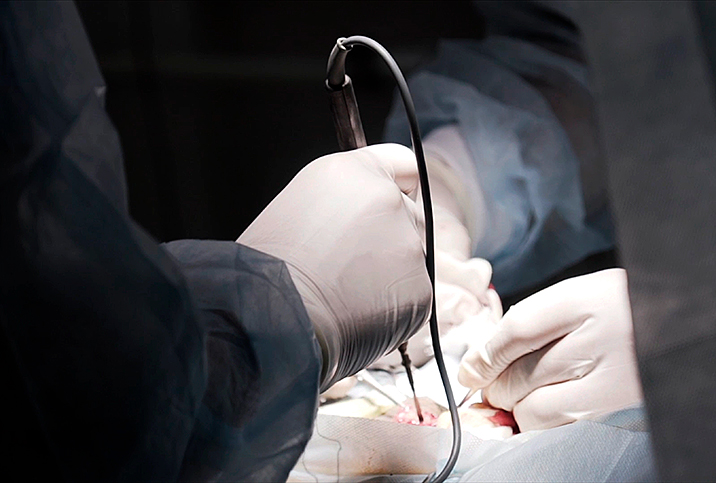Say Goodbye to Peyronie's Acute Phase Structural Changes

Peyronie's disease, a connective tissue disorder of the penis marked by curved, sometimes painful erections, comes in two distinct phases: the acute (active) phase and the chronic (stable) phase.
The acute phase involves active inflammation in the erectile tissue of the penis and the buildup of fibrous scar tissue. The main characteristics of this phase, which can last up to 18 months, are painful erections and changes in the curvature or indentation of the penis. The curvature or indentation often gets progressively worse during the active phase.
"At some point, everything stabilizes, and those structural changes stop worsening," said Bobby Najari, M.D., a urologist at NYU Langone Health in New York City. "When there's no more structural change in the penis and the erection, and there's no pain associated with an erection for at least three months, that's considered the stable phase of Peyronie's disease."
Najari clarified that a man with significant penile curvature could have challenges penetrating their partner, which can lead to pain. However, this is pain with sexual activity, which characterizes the chronic phase—pain with erections characterizes the acute phase.
Arthur Louis Burnett, M.D., a professor of urology at Johns Hopkins University in Baltimore, pointed out that Peyronie's disease has a natural history, and patients notice an onset of symptoms during the acute phase. The chronic phase typically comes along within six to 12 months of recognizing something starting to happen.
"Often, men will have the acute pain sensation subside, maybe some of the achiness that correlates with the inflammatory condition starts to subside, and your body heals up," Burnett explained. "It's left a scar in the penis many times, or a deformity, and maybe some changes in the ability to get the best erection."
What are Peyronie's treatment options?
Pending the severity of the stabilized state of the penis, action might be necessary.
"It depends on what each person's presentation is all about," Burnett said. "There are degrees of severity. For those with lesser severity, we'll just reassure them and say, 'Hopefully, it's stabilized and nothing will happen further to your penis going forward.'"
For example, if a man's penis has a 15-degree curvature, is still usable, and the erections are fine, treatment may not be needed. If a man's curvature is relatively minimal but their erections are compromised, they may only need oral medications, such as Viagra or Cialis.
"If a man has either a functional issue of erection changes or structural issue of penile deformity that's significant enough to impede the active intercourse, then we need to take action," Burnett said.
One of the most commonly used noninvasive treatments is a penile traction device, which stretches the flaccid penis in a direction opposite from where the Peyronie's is pulling the erection.
"The goal of that is just to make that scar tissue more elastic and to help the remodeling of that scar tissue happen in a direction that's favorable," Najari said. "They can just be done at home. You can get these devices directly from manufacturers or online."
The devices require patience and commitment, Najari noted, because they generally need to be used for at least an hour each day to be beneficial.
Medications can be injected directly into the scar tissue. However, the only one approved by the Food and Drug Administration (FDA) for the stable phase is Xiaflex, a collagenase that breaks down abnormal collagen in the penis.
"While there is some research being done on using it in the active phase, most of the evidence on its efficacy is in the stable phase, and so that's a very common treatment option," Najari said, adding that injections are often given in conjunction with the penile traction device to augment the effectiveness. "You're softening or breaking up the scar with the Xiaflex medications and then using traction to help guide the remodeling of the scar tissue in the desired direction."
Surgical options for Peyronie's
Men with a severe case of penile curvature may opt for the most effective—and most invasive—option, which is penile straightening surgery. Surgical options are available only for men in the stable phase. One of the common surgical procedures is plication, which involves tightening the excess tissue on the outer side of the curvature with a series of stitches.
"You're kind of balancing out the penis by putting the stitches on the opposite side of the penis, and those stitches are put directly into the erectile tissue underneath the skin," Najari said.
Another surgical option is incision and grafting, where the surgeon cuts into the penis to release the tissue the scar tissue created. According to Najari, the procedure basically releases the tension and opens up a gap in the erectile tissue, which is then patched with biological or synthetic material.
Penile implants may also be an option. These are inflatable prosthetic devices placed inside the erectile tissue. They can be used to treat mild Peyronie's accompanied by erectile dysfunction or used in combination with plication or incision and grafting.
See a urologist
If you think you have Peyronie's disease, don't hesitate to seek treatment. Najari said it's important for men to know that an invasive treatment will not be pushed on them. There are many treatment options, and most men end up selecting less invasive options, such as penile traction devices or injections.
"This isn't a dangerous condition," Najari said. "While it's distressing, they should at least take comfort in the fact it's not going to endanger their physical health at all, like some kind of cancer would."




















